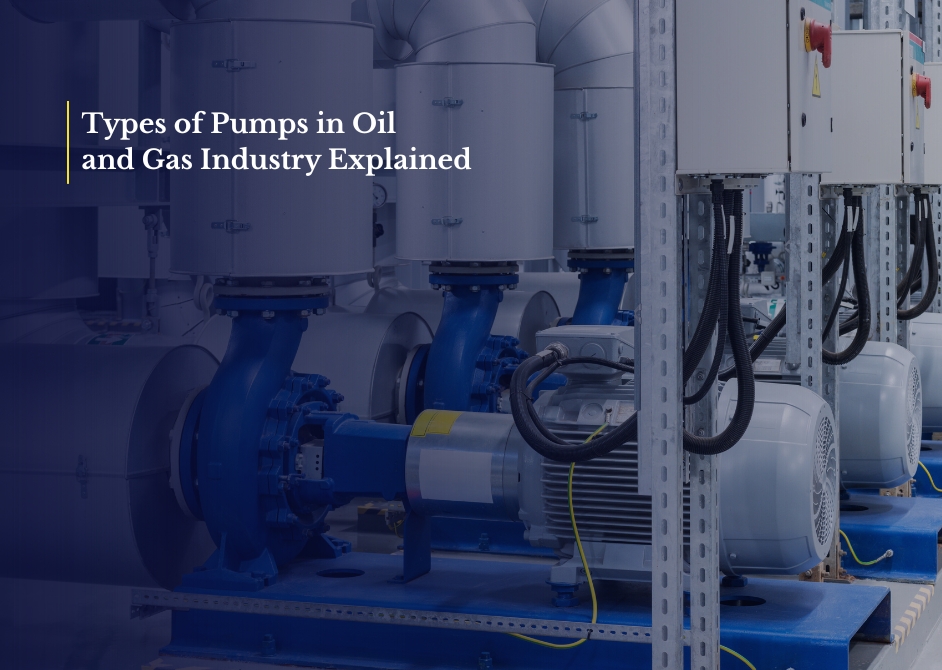Pumps consume nearly 10% of energy in oil and gas operations, making their selection vital for efficiency and cost control. They support critical tasks such as crude transfer, water injection, chemical dosing, and high-pressure flow across upstream, midstream, and downstream stages, often operating under extreme pressure, temperature, and corrosive conditions.
A poor pump choice can result in failures, downtime, and safety concerns, while the right pump ensures smooth performance, regulatory compliance, and reduced operational costs.
To make informed decisions, it's important to review the main types of pumps in oil and gas industry and understand how each supports specific process requirements.
Key Takeaways
- Pumps in oil and gas industry play a central role in crude transfer, gas movement, water injection, and chemical dosing.
- The right pump depends on key factors like pressure, temperature, flow rate, viscosity, and fluid composition.
- Common types include centrifugal, reciprocating, diaphragm, gear, screw, peristaltic, and jet pumps, each with its own strengths.
- Matching the pump type to the application ensures safer operations, lower maintenance, and long-term efficiency.
- A strong understanding of pumps in oil and gas industry helps you choose equipment that fits your process and performance needs.
Now that you have a basic overview, it’s easier to understand how pumps are applied in day-to-day operations.
Understanding the Role of Pumps in Oil and Gas Industry
In the oil and gas sector, pumps are used to move various fluids such as crude oil, natural gas liquids, water, and chemicals across different stages of production, transportation, and processing.
Instead of transferring fluids in fixed volumes, these pumps work by generating pressure or velocity to maintain continuous flow. They are built to handle fluids of different viscosities, temperatures, and pressures. Their strong construction and reliable operation make them essential for demanding industrial environments.
Once you understand how these pumps function, it becomes easier to see how they are applied in key operations across the oil and gas value chain.
Key Uses of Pumps in Oil and Gas Operations
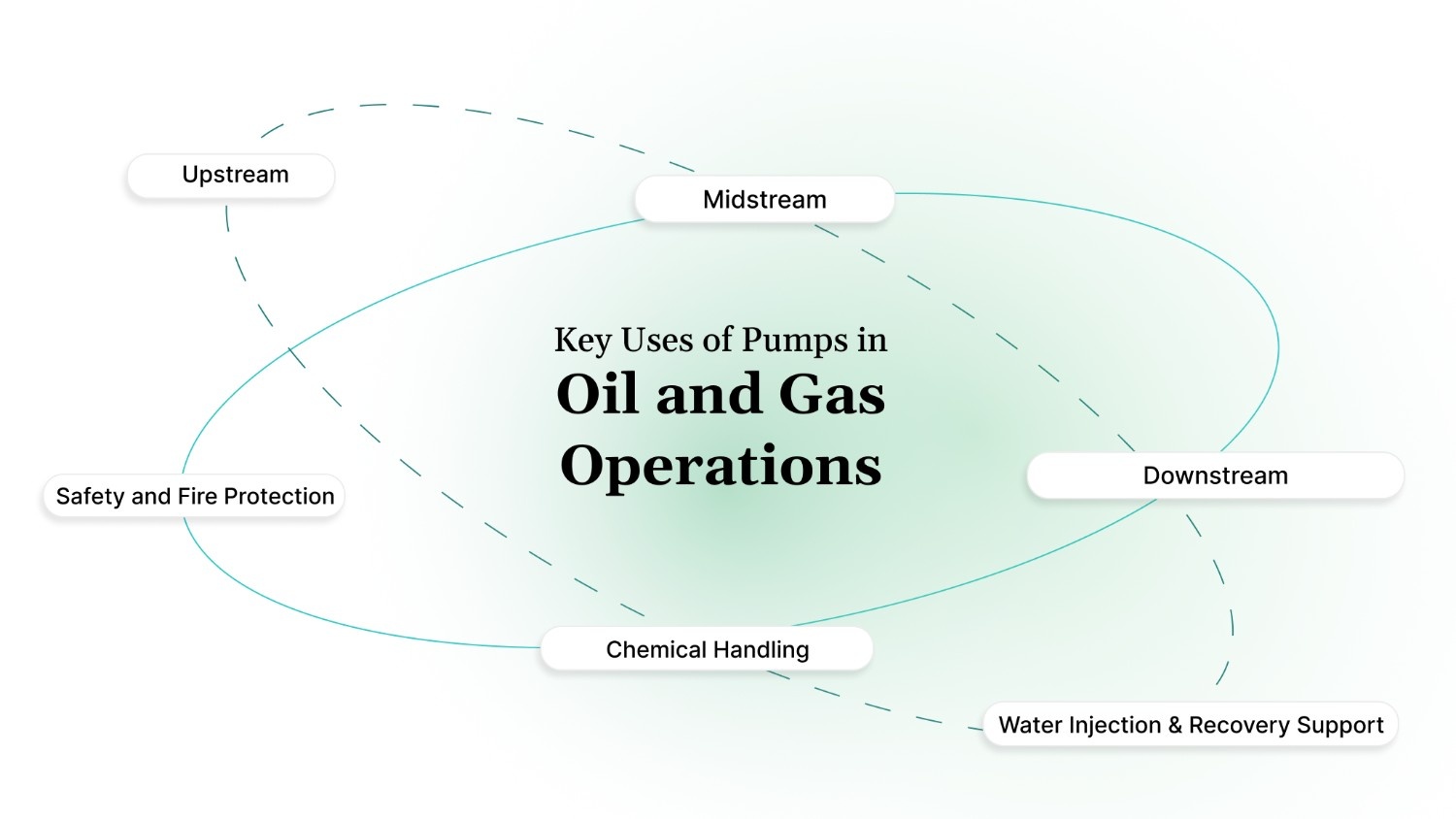
Pumps are central to nearly every process in the oil and gas industry. From offshore drilling to pipeline transport and refinery systems, pumps keep fluid movement steady and efficient.
Here’s how different types of pumps are typically used in oil and gas:
- Upstream (Exploration and Production): Pumps circulate drilling fluids, inject water or chemicals into wells, and lift oil or gas from the reservoirs to the surface.
- Midstream (Transport and Storage): Large pumps move oil and gas through pipelines across long distances, support loading and unloading at terminals, and help maintain consistent pressure in the system.
- Downstream (Refining and Distribution): Pumps are used for separating crude into products, blending chemicals, cooling processing units, and transferring fuels such as diesel or petrol to storage tanks.
- Water Injection and Recovery Support: High-pressure pumps are used to push water or gas back into the reservoir to increase oil recovery.
- Chemical Handling: Metering pumps help dose corrosion inhibitors, treatment chemicals, or additives with high precision.
- Safety and Fire Protection: Standby pumps are used in fire-fighting systems and during emergencies where rapid fluid movement is required.
To achieve consistent and safe performance in these areas, choosing a pump that suits fluid properties and site conditions is essential.
Key Types of Pumps in Oil and Gas Industry
Pumps play a vital role in oil and gas operations, from extraction to refining. They fall into two main categories: centrifugal and positive displacement.
Centrifugal pumps handle high-flow, low-viscosity fluids using high-speed rotation, while positive displacement pumps move thick or volatile fluids in fixed volumes, ideal for high-pressure or precision dosing tasks.
To choose the right pump, it helps to understand how each type works and where it fits best.
Now it’s time to look at each pump type in detail.
1. Centrifugal Pumps
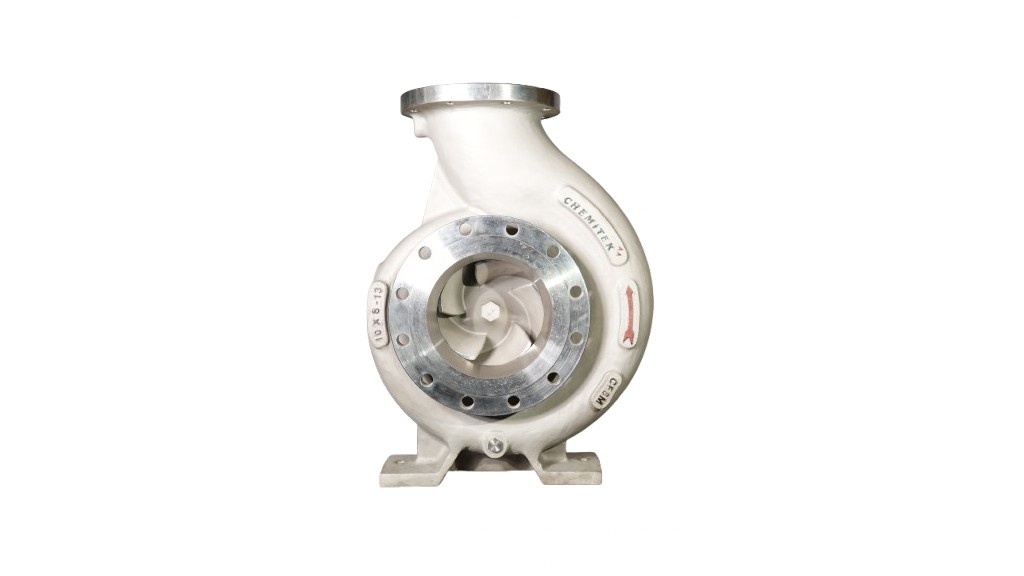
Centrifugal pumps are widely used in oil and gas facilities for transferring large volumes of low-viscosity fluids at moderate pressure. They operate by converting rotational energy into fluid motion using an impeller.
Key Features:
- Materials like SS316, duplex steel, or high-nickel alloys are used for corrosion resistance. Sealing options include mechanical seals or magnetic drives for leak-free performance.
- These pumps function by converting mechanical energy from a motor into kinetic energy via a rotating impeller, ensuring high flow rates with relatively low maintenance.
Core Construction Materials and Design Focus
Among the many types of pumps in the oil and gas industry, centrifugal variants come in several designs. Here's a breakdown of the common types and their typical applications.
a. Single-Stage Centrifugal Pumps
These pumps are used for stable, continuous flow in low to moderate head applications, making them reliable for routine transfer duties in oil and gas facilities.
Applications: Transporting cooling water, seawater, or transfer of light hydrocarbons between tanks or treatment stages in upstream and downstream processes.
b.Multi-Stage Centrifugal Pumps
Multi-impeller design allows these pumps to develop high discharge pressure, suitable for long-distance or high-head oilfield fluid movement.
Applications: Crude transfer across pipeline segments, reinjection of treated produced water, high-pressure wash systems in gas processing plants, and export line circulation.
c. Submersible Centrifugal Pumps
These fully enclosed pumps are installed below the fluid level and are ideal for deep well or submerged sump applications where surface space is limited.
Applications: Artificial lift in onshore oil wells, pit drainage on rigs, produced water pumping in offshore platforms, and emergency flood control in refineries.
d. Vertical Centrifugal Pumps
With their compact footprint and vertical construction, these pumps suit confined installations and variable fluid levels in tanks or reservoirs.
Applications: Transferring condensate from collection tanks, offloading storage tank bottoms, hydrocarbon recovery from separators, and cooling tower return loops.
e. Horizontal Centrifugal Pumps
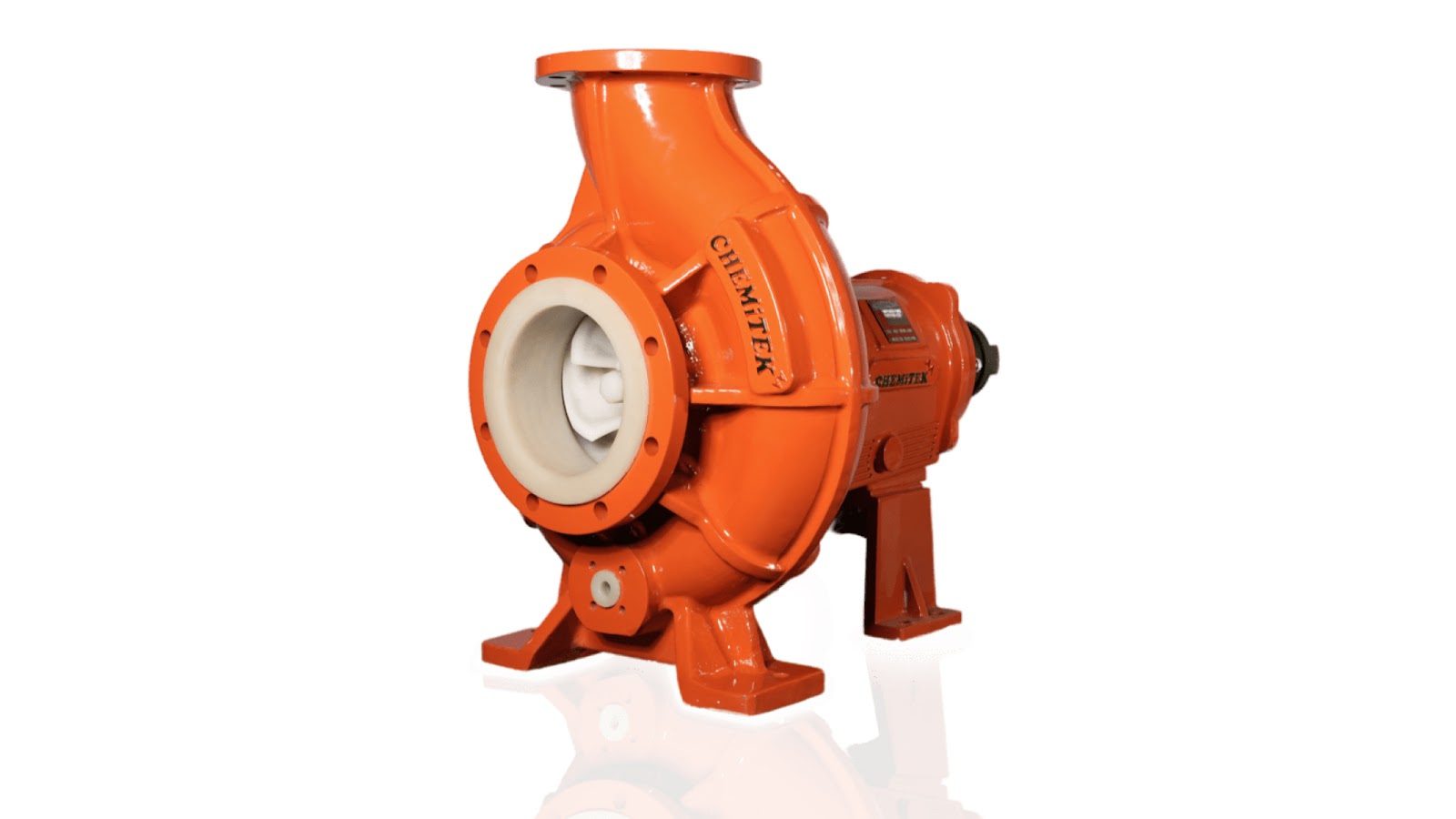
Mounted on a baseplate with a horizontal shaft alignment, these horizontal centrifugal process pumps offer easy maintenance and are widely used for surface-level fluid transfer in stable setups.
Applications: Crude oil loading and unloading, chemical transfer in refineries, general-purpose circulation duties, and cooling water handling in power blocks.
f. Magnetic Drive Centrifugal Pumps (Sealless)
Designed for hazardous or emission-sensitive fluids, these pumps offer leak-free performance without mechanical seals, reducing environmental and safety risks.
Applications: Circulating glycol in dehydration units, methanol injection in offshore platforms, handling aromatics and solvent-based fluids in petrochemical units, and acid dosing in gas treatment plants.
For high pressure or viscous fluids, centrifugal pumps fall short, that’s where positive displacement pumps step in.
2. Positive Displacement Pumps
Positive displacement pumps are a key category within the types of pumps in the oil and gas industry, particularly valued for their ability to handle thick, abrasive, and high-viscosity fluids with precision.
Key Features:
- These pumps maintain consistent flow regardless of discharge pressure, making them well-suited for chemical injection, multiphase fluid handling, and high-pressure applications.
- They're often used in upstream and midstream segments for tasks that require accuracy and durability under extreme conditions.
Core Construction Materials and Design Focus
Just like centrifugal pumps, positive displacement pumps come in various types, here’s a quick look at the common types and their applications.
a. Gear Pumps
Compact and robust, gear pumps are suited for steady, pulse-free flow of viscous fluids under moderate pressure conditions.
Applications: Circulating lube oil in compressor skids, fuel oil transfer in boiler systems, and loading heavy crude at terminal stations.
b. Diaphragm Pumps
Engineered for chemically aggressive or abrasive media, these pumps provide safe, leak-free operation with minimal maintenance.
Applications: Injecting acids and solvents in desulfurization units, transferring spent caustic in refinery processes, and dosing corrosion inhibitors offshore.
c. Metering Pumps
Designed for accuracy, metering pumps deliver precise volumes in controlled rates, making them vital in fluid dosing systems.
Applications: Chemical injection in wellheads, anti-foam dosing in separators, demulsifier addition in crude treatment, and additive blending in fuel formulation.
d. Progressive Cavity Pumps
Their helical rotor design allows smooth handling of thick or shear-sensitive fluids without agitation or pulsation.
Applications: Transferring crude emulsions in production trains, feeding polymers in enhanced oil recovery (EOR), and moving sludge from separator bottoms.
e. Reciprocating Pumps (Piston/Plunger)
These pumps deliver high pressure with strong suction capabilities and long service life, even in abrasive environments.
Applications: Water injection into reservoirs, glycol circulation in gas dehydration, chemical squeeze treatments in oil wells, and hydraulic fracturing support.
f. Screw Pumps
Efficient for handling viscous or multiphase fluids, screw pumps provide smooth, non-pulsing flow even under variable inlet conditions.
Applications: Multipurpose crude transfer from tank farms, multiphase flow from wellheads to separators, and offloading high-viscosity products at jetty terminals.
3. Other Pump Variants
In addition to the core categories, certain specialized pump types serve niche roles in oil and gas systems.
a. Jet Pumps
Jet pumps use a high-velocity motive fluid to create suction and lift formation fluids without any mechanical moving parts. They are efficient in handling fluid recovery where conventional lift mechanisms fall short.
Applications: Ideal for artificial lift in depleted or marginal wells, well cleanups, and recovering formation fluids from low-pressure zones during early production stages.
b. Peristaltic Pumps
These pumps compress flexible tubing to move fluids in a gentle, low-shear manner, making them suitable for slurry-laden or chemically reactive liquids that require contamination-free handling.
Applications: Used in chemical dosing for refining operations, waste sludge transfer in treatment systems, and metering abrasive or corrosive additives in drilling fluid circulation.
c. Rotary Pumps
Rotary positive displacement pumps provide smooth, pulse-free flow across a wide viscosity range. Their sealed internals and high efficiency make them effective for transferring thick or shear-sensitive fluids.
Applications: Common in lube oil systems, asphalt and bitumen transfer, loading/unloading of fuel oils, and recirculation of heavy crude in tank storage or blending facilities.
With a clear view of the types of pumps in oil and gas industry, the next step is understanding how to choose the right one based on your process requirements and site conditions
How To Select the Right Pump for Oil and Gas Applications?
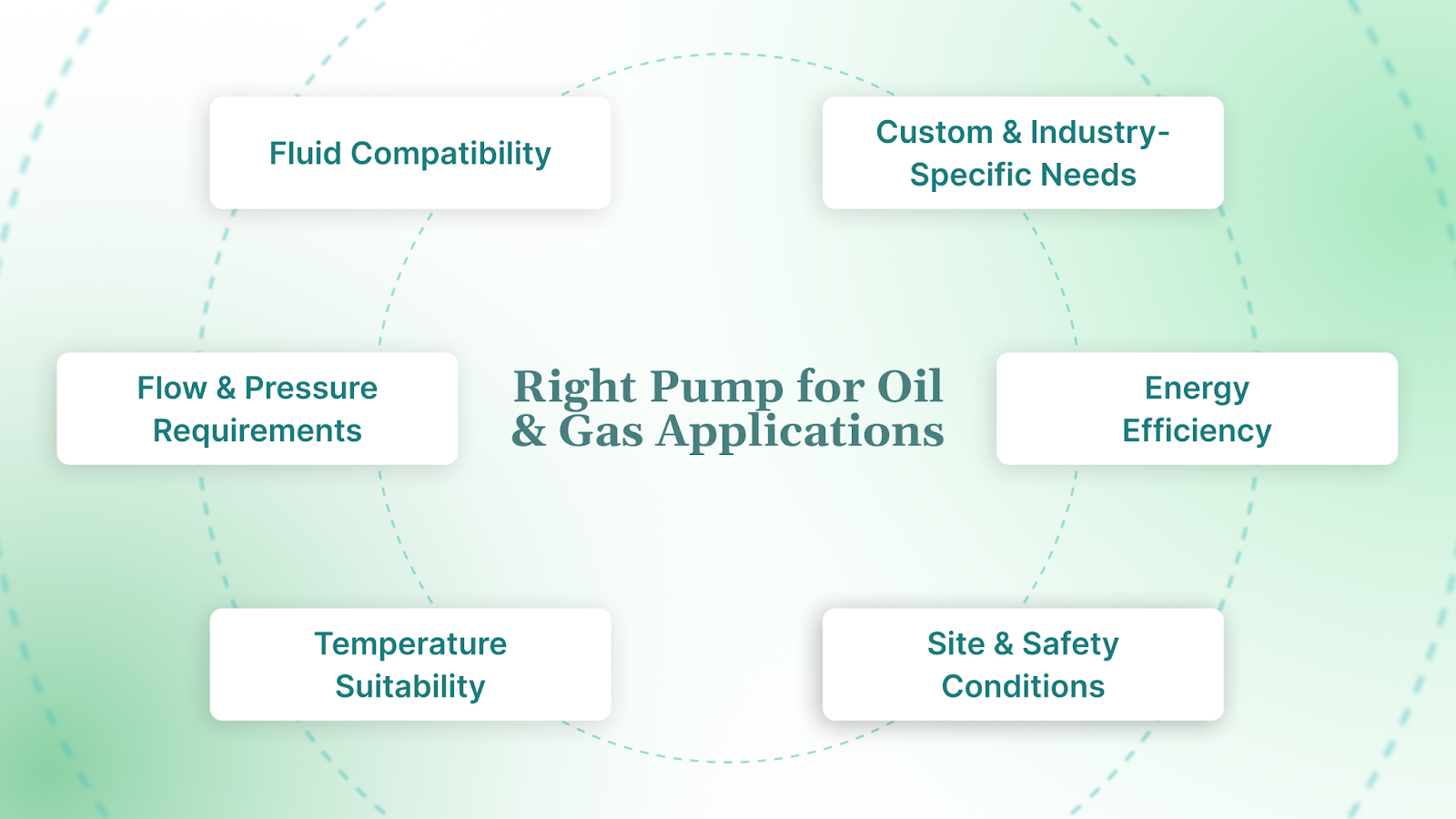
Efficient fluid handling in the oil and gas industry depends on selecting pumps that suit your application’s pressure, temperature, and chemical compatibility. A wrong choice can lead to leakage, wear, or downtime.
Here’s a practical breakdown to help you identify the right pump for your oil and gas system.
- Fluid Compatibility: Use slurry pumps with wear-resistant liners for abrasives. For corrosive or toxic fluids, choose non-metallic centrifugal pumps in PVDF, fluoroplastics, or metals like SS316, Alloy 20, ANSI-Compliant or Hastelloy, suitable for acids, sour gas, and low pH chemicals.
- Flow and Pressure Requirements: Select horizontal multistage centrifugal pumps rated for 150–300 m³/hr and up to 60 bar for long-distance transfer or reinjection. These are suitable high pressure centrifugal pumps for upstream and downstream operations.
- Temperature Suitability: Use stainless steel centrifugal pumps for cryogenic fluids like LNG at –160°C. For high-heat services, go for thermal oil pumps or high temperature centrifugal pumps that handle up to 350°C.
- Site and Safety Conditions: In space-constrained areas, choose horizontal centrifugal pumps or inline centrifugal pumps. For hazardous locations, use pumps with flameproof motors certified for ATEX or Zone 1.
- Energy Efficiency: Consider energy efficient chemical pumps to reduce operating costs. ANSI centrifugal pumps are preferred when standardisation, reliability, and easy servicing matter.
- Custom and Industry-Specific Needs: For chemical, pharma, fertilizer, wastewater, or oil and gas use, choose a custom process pump manufacturer. Metallic, magnetic drive, and sealless centrifugal pumps offer reliable, leak-free performance.
Looking for reliable pumps in oil and gas industry applications? Match pump type to your fluid, pressure, and site conditions. Explore your options here.
Chemitek: High-Performance Pumps for Energy Applications
Since 2009, Chemitek Process Equipment Pvt. Ltd. has delivered precision centrifugal pumps built for challenging oil and gas operations. Our range includes API 610 compliant pumps, ANSI/ASME B73.1, magnetic drive pumps, high-temperature models, and self-priming designs suitable for both upstream and downstream use.
Pumps in oil and gas industry are engineered to handle corrosive, high-pressure, and hazardous fluids, our models are built with durable materials like SS316, Alloy 20, and Hastelloy. Each pump is developed using advanced CAD/CAM systems and meets global safety and performance standards.
Reach out today to discuss your flow requirements, material compatibility, or site-specific needs. Our team is ready to help you choose the right solution for long-term performance.
FAQs
1. How are pumps selected for upstream oil production?
For upstream processes like crude extraction and wellhead services, positive displacement pumps and high-pressure centrifugal pumps are often used. These handle multiphase fluids, sand-laden slurries, and fluctuating flow rates effectively.
2. What pump types are ideal for offshore oil platforms?
Offshore setups prefer API 610 vertical inline and multistage pumps for space efficiency and reliability. These pumps manage seawater injection, crude oil transfer, and cooling applications under high pressure and corrosive conditions.
3. How do pumps handle corrosive fluids in refineries?
In refining, magnetic drive or ANSI chemical process pumps with corrosion-resistant materials like Hastelloy or Alloy 20 are chosen to manage acids, amines, or caustics without leakage or metal degradation.
4. Why is seal design critical in oil and gas pumps?
Seal failures can lead to hazardous leaks. Pumps used in this industry often use double mechanical seals or sealless designs to contain toxic, flammable, or high-temperature fluids safely.
5. What role do pumps play in pipeline systems?
Pipeline transport relies on horizontal multistage centrifugal pumps that maintain steady pressure across long distances. These pumps are built to handle crude oil, condensate, or refined fuels in both hot and cold environments.
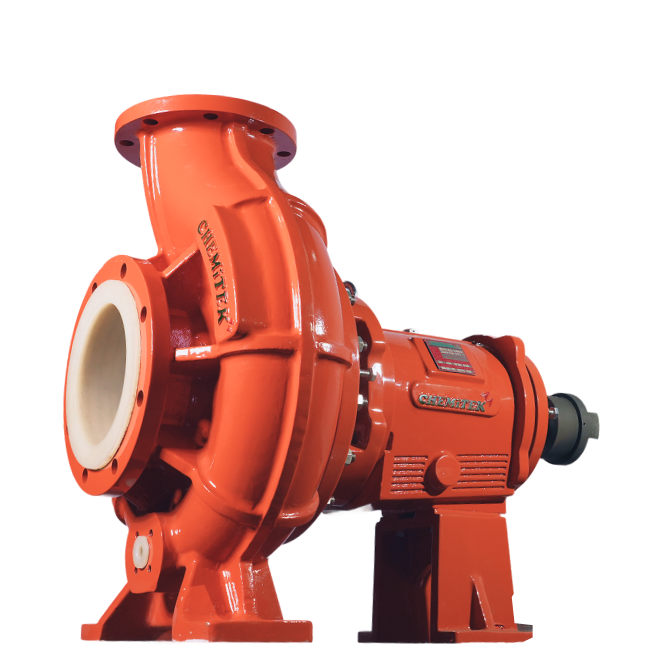
Latest posts
Ready to Upgrade Your Process Operations?
